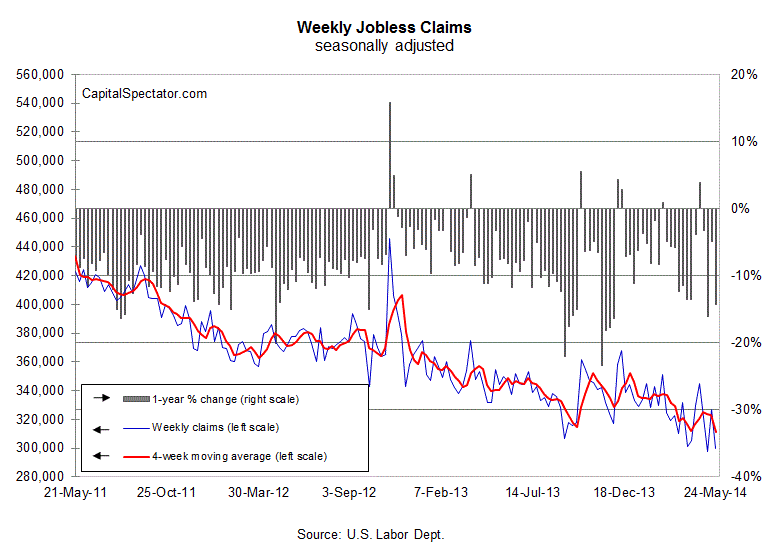Today’s revised GDP report for this year’s first quarter looks dismal. Growth was considerably weaker than expected, with economic activity slumping 1.0% in the first three months of the year on a seasonally adjusted annualized basis. That’s quite a bit lower than the 0.1% gain in the initial estimate. But the GDP report, which isn’t all that valuable for real-time business cycle analysis, is misleading if you read it in a vacuum. Indeed, more recently updated economic reports paint a considerably brighter picture, including today’s news on jobless claims, which dipped to the lowest level since August 2007.
I’ve never been a big fan of GDP data, in part because it arrives with a significant lag. In the crucial work of monitoring the business cycle, GDP reports are low-priority events in my view. Ideally, these numbers will confirm what’s already clear by looking at individual economic releases that have been previously published. But even that’s asking for too much. There are major flaws in the methodology for estimating one data point to summarize an entire economy. Trying to estimate the output of the US economy, the world’s largest, is much more of art than science compared with calculating, say, industrial production, payrolls, and other narrowly focused data sets. The quarterly time period isn’t useful either, as it takes away valuable nuance in the economic fluctuations that are conspicuous in a monthly framework. Focusing on GDP numbers forces us to ignore all the macro intelligence that reflects economic activity from April 1 onward. Analyzing the economy is hard enough without embracing artificial blinders.
Today’s jobless claims release offers a reminder of why we should look elsewhere for comparatively reliable signals of recession risk. New filings for unemployment benefits decreased by a hefty 27,000 to a seasonally adjusted 300,000 for the week through May 24, or well below expectations. That alone doesn’t tell us much. On the other hand, the generally sliding trend with claims in recent months is a strong signal for thinking that the economy, if not poised to accelerate, is at least on a steady course to deliver moderate growth for the foreseeable future. Unless, of course, you accept the implied analysis of today’s GDP revision: a new recession started in Q1. Maybe, but there’s quite a lot of data that’s been published over the past two months that tell us otherwise.
For instance, note that claims are lower by more than 14% on a year-over-year basis through last week. That’s a powerful indicator for anticipating that the economy’s capacity to create jobs on a net-positive basis will roll on. In short, it’s unlikely that recession risk is rising when the labor market is expanding.
Jobless claims are valuable, but they’re not flawless and so we should also consider a broad mix of numbers. The good news is that a wider spectrum of data doesn’t conflict with the upbeat message in claims. Reviewing a diversified mix of economic and financial indicators implies that the US economy is unlikely to slip into the business cycle ditch in the immediate future. If you only looked at GDP data, however, you’d have a distinctly different and darker outlook. Fortunately, there’s no reason why should limit ourselves to the questionable business cycle signals that flow from quarterly GDP reports.

Pingback: Is Q1 GDP Data Misleading Us? – The Capital Spectator | Marty Investor
Pingback: Private Sector Payrolls Increase in May